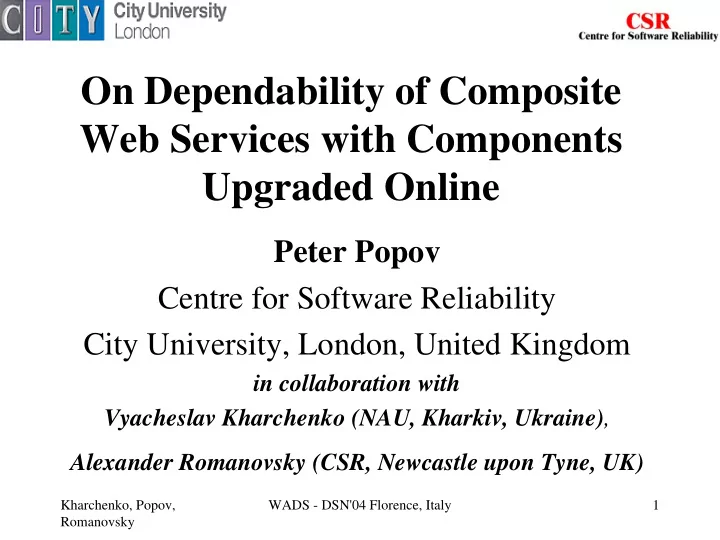

On Dependability of Composite Web Services with Components Upgraded Online Peter Popov Centre for Software Reliability City University, London, United Kingdom in collaboration with Vyacheslav Kharchenko (NAU, Kharkiv, Ukraine) , Alexander Romanovsky (CSR, Newcastle upon Tyne, UK) Kharchenko, Popov, WADS - DSN'04 Florence, Italy 1 Romanovsky
Objectives • Confidence in correctness of Web-services – why – how • On-line upgrade of component services and its impact on composite Web-services – confidence in correctness of composite service – architectures for on-line upgrade Kharchenko, Popov, WADS - DSN'04 Florence, Italy 2 Romanovsky
Background: Web-services • A series of standards which made interoperability ‘easy’: – extendable WS descriptions kept and updated online in a registry – flexible binding, etc. • Composite Web-service may depend on existing component services and on off-the-shelf (OTS) software – Composite web-services vs. integration of OTS software • similar in the absence of detailed information about their development • ‘locked-in’ with the provider of the component web-service URL:Node 1 Web-Service 1 URL:My Node WS1 Composite Web-Service Composite WS URL:Node 2 Web-Service 2 WS 2 Kharchenko, Popov, WADS - DSN'04 Florence, Italy 3 Romanovsky
Background: Confidence in correctness • Used in probabilistic assessment of safety-critical software: – done off-line (pre-deployment and periodic reviews) – with WS the same idea can be taken further and the confidence can be published and updated continuously . • Bayesian inference (a way of calculating confidence) – a mathematically sound mechanism which allows one to combine the a priori knowledge and new empirical evidence (new observations) – detailed modelling of systems with many components leads to computational difficulties but feasible under plausible simplifications • Confidence in system correctness can be calculated continuously – knowledge about the components only is NOT enough – solutions to this problem exist (previous work for safety-critical applications) Kharchenko, Popov, WADS - DSN'04 Florence, Italy 4 Romanovsky
Bayesian inference: illustration Bayesian inference: Effect of 'testing' on uncertainty in service pfd 0.14 3 failures in 1000 tests 0.12 30 failures in 10 000 0.1 40 failures in 10 000 P(pfd) 0.08 0.06 0.04 0.02 0 0.0000 0.0017 0.0033 0.0050 0.0067 0.0083 0.0100 0.0117 0.0133 0.0150 pfd • pfd - probability of failure on demand. • Probability of correct execution is a real number: P(correct execution on demand)=1-E[pfd] • Slightly more complicated with several components. Kharchenko, Popov, WADS - DSN'04 Florence, Italy 5 Romanovsky
Example: Confidence in correctness of WS WSDL without confidence: <types> <s:schema … > <s:element name=”Operation1Request”> <s:complexType> <s:sequence> <s:element minOccurs=”0” maxOccurs=”1” name=”param1” type=”s:int”> <s:element minOccurs=”0” maxOccurs=”1” name=”param2” type=”s:string”> </s:sequence> </s:complexType> </s:element> <s:element name=” Operation1Response ”> <s:complexType> <s:sequence> <s:element minOccurs=”0” maxOccurs=”1” name=”Op1Result” type=”s:string”> </s:sequence> </s:complexType> </s:element> … </types> Kharchenko, Popov, WADS - DSN'04 Florence, Italy 6 Romanovsky
Confidence in correctness (2) WSDL with confidence (1) redefining the old response: <s:element name=” Operation1Response ”> <s:complexType> <s:sequence> <s:element minOccurs=”0” maxOccurs=”1” name=”Op1Result” type=”s:string”> <s:element minOccurs=”0” maxOccurs=”1” name=” Op1Conf ” type=”s:double”> </s:sequence> </s:complexType> </s:element> • This may ‘break’ the existing composite services. Kharchenko, Popov, WADS - DSN'04 Florence, Italy 7 Romanovsky
Confidence in correctness (3) WSDL with confidence (2) a new operation defined: <s:element name=” OperationConfRequest ”> <s:complexType> <s:sequence> <s:element minOccurs=”0” maxOccurs=”1” name=”operation” type=”s:string”> </s:sequence> </s:complexType> </s:element> <s:element name=” OperationConfResponse ”> <s:complexType> <s:sequence> <s:element minOccurs=”0” maxOccurs=”1” name=”Op1Conf” type=”s:double”> </s:sequence> </s:complexType> </s:element> Kharchenko, Popov, WADS - DSN'04 Florence, Italy 8 Romanovsky
Architectural implications of calculating Confidence in WS • Confidence ( Op1Conf or OperationConfResponse ) ‘continuously updated’: – the confidence of a particular user A will be affected by the other users of the same WS (cost of ‘testing’ shared between the users) • Some performance penalty (due to continuous Bayesian inference): – with every invocation of the operation (may be prohibitively expensive, especially under heavy load) – predefined intervals to make it ‘cheaper’ – adaptive scheme (supported by system architecture) of changing the intervals of calculating confidence depending on the load on WS. Kharchenko, Popov, WADS - DSN'04 Florence, Italy 9 Romanovsky
On-line upgrade of a component WS URL:My Node URL:Node 1 Web-Service 1.0 Composite Web-Service WS1.0 Composite WS Web-Service 1.1 WS1.1 URL:Node 2 Web-Service 2 WS 2 • A new release of WS1 is available. Confidence in the Composite WS can be calculated after the upgrade • Possible architectural solutions for the service upgrade: – Both the old and the new releases, WS1.0 and WS1.1, are available: • continue using WS1.0 until the confidence in WS1.1 reaches ‘acceptable’ level. The architecture of the Composite WS should cater for the ‘transitional’ period – The new release WS1.1 replaces WS1.0. Some drop of confidence is possible. If not acceptable switch to using a different component WS. Kharchenko, Popov, WADS - DSN'04 Florence, Italy 10 Romanovsky
Conclusions • On-line assessment of confidence in correctness of Web-services proposed: – Various ways of publishing this confidence discussed • Architectures of Composite WSs needed that allow for management of: – the cost of keeping the confidence in the correctness of the service up to date (changing the frequency of updates of the confidence to minimise the performance penalty) – the transitional period between the releases of the component services: • whether to switch from the previous release of a WS to a new one or not • whether to switch to an alternative component service if the new release ‘not good enough’ • Questions Kharchenko, Popov, WADS - DSN'04 Florence, Italy 11 Romanovsky
Recommend
More recommend